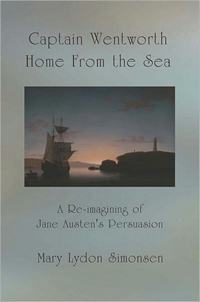 From the desk of Lucy Warriner:
From the desk of Lucy Warriner:
If your lost love returned with no recollection of the dispute that separated you, how would you react? If you had a second chance at happiness with him, would you divulge your tumultuous past? Anne Elliot faces these questions in Captain Wentworth Home from the Sea, Mary Lydon Simonsen’s new “what-if” retelling of Persuasion.
When the straitened Sir Walter Elliot lets Kellynch Hall to the Crofts, Frederick Wentworth joins his sister and brother-in-law at the estate. Sophia and Admiral Croft are helping Frederick recover from a head injury that destroyed his memory and compelled his retirement from the navy. In the absence of the housekeeper, Anne agrees to remain at Kellynch for a week after her family’s departure. Though certain that Frederick does not remember her ending their engagement eight years earlier, she is wary of his brusqueness. Though he disparages her reading habits during their first encounter, Frederick soon recognizes that Anne is a person of substance. Intrigued by the peace her presence brings him, he gradually draws her out.
Without Anne’s family’s negative influence, she is determined to enjoy her time with Frederick and extends her stay at Kellynch. Meanwhile, Frederick thinks of proposing to her. Sophia scolds him for considering marriage when he respects Anne rather than loves her. But Sophia’s account of the unknown love who spurned Frederick in 1806 (unfortunately, he never named her in his letters) supports his belief that romance does not guarantee happiness. Though this lost love also seems to be haunting his dreams, Frederick is resolute about starting anew with Anne. But what will happen when he proposes? Will Anne disclose the details of their first courtship?
Simonsen excels in her characterization of Frederick, a keen and acerbic observer of human nature. When Anne’s sister Elizabeth fishes for compliments about Kellynch, Frederick informs her that he has seen so many country estates that one is quite like another. He then declares that Kellynch is an unremarkable house with merely adequate landscaping. Frederick also tells Sophia that Anne’s married sister Mary Musgrove complains “like a petulant child,” and he asks Anne, “Her [Mary’s] illnesses come and go, do they? Do they ‘come’ so you will ‘go’ to Uppercross?” p. 28 and p. 36. Yet where he finds goodness—and he tells Anne that her intentions are always good—Frederick is gentle. When Anne is overburdened with household responsibilities, he convinces her to go riding with him. When she is demoralized about selling her mother’s furniture to cover debts, he purchases it as a gift for her.
Simonsen’s Anne is realistically flawed, a strong woman who makes some mistakes while trying to overcome her past. Venerable forcefulness underlies Anne’s usual mildness. Acutely aware that life has been “cruel” to her, she protects herself from further exploitation by defying Mary’s demand that she come to Uppercross. When Frederick proposes, Anne bars him from speaking to her father, Sir Walter. She also ignores neighbor, and former advisor, Lady Russell’s attempts to foist Mr. Elliot on her. Yet for all her assertiveness, Anne is terribly vulnerable on the subject of her past. She wants to be known “in her new incarnation” as a woman who never disappointed Frederick because she thinks that leaving him eight years earlier was indefensible. It is difficult to fault Anne for lying by omission when she is in love and clinging fast to happiness. But it is also difficult to witness her self-belittlement in wishing to be an idealized version of herself. Despite her regrets, Austen’s Anne maintains that, bad as their advice was, she acted responsibly in consulting her elders about her first engagement to Frederick. Were Simonsen’s Anne this secure, she might sooner realize that she deserves to be loved for who she really is, her lapse of judgment notwithstanding.
Overall, Captain Wentworth Home from the Sea is a very pleasant diversion for Persuasion enthusiasts. Simonsen respects the intensity of Anne and Frederick’s love, and her alterations to Austen’s plot are neither extreme nor implausible. Readers may want a lengthier resolution to the novella, with more conversation and/or conflict between the characters. Yet, this is all the more reason to hope that Simonsen will eventually attempt a full-length work about Anne and Frederick.
4 out of 5 Stars
Captain Wentworth Home from the Sea: A Re-imagining of Jane Austen’s Persuasion, by Mary Lydon Simonsen
Quail Creek Publishing, LLC (2011)
Paperback (136) pages
ISBN: 978-0615549668
NOOK: BN ID: 2940013210547
Kindle: ASIN: B006073D7E
Cover image courtesy of Quail Creek Publishing © 2011; text Lucy Warriner © 2012, Austenprose.com
I reviewed this book today too, but you said it much better than I did! ;)
LikeLike
Hi Lucy. Thank you so much for your wonderful review. What a pleasant surprise to find this in my RSS feed! The older I get the more I love Persuasion!
LikeLike
Ah, I am so glad to see that the Persuasion story is getting a ‘what if’ story. I have the book and look forward to reading it.
Glad to read your positive review!
LikeLike